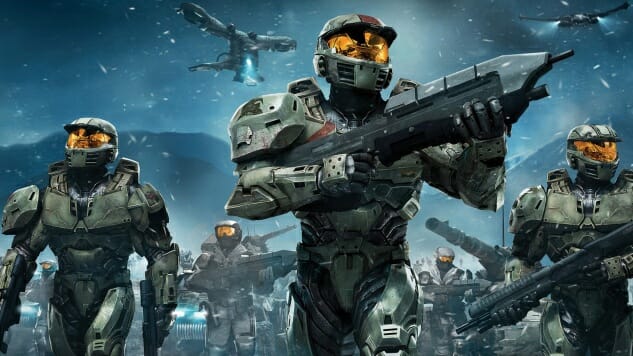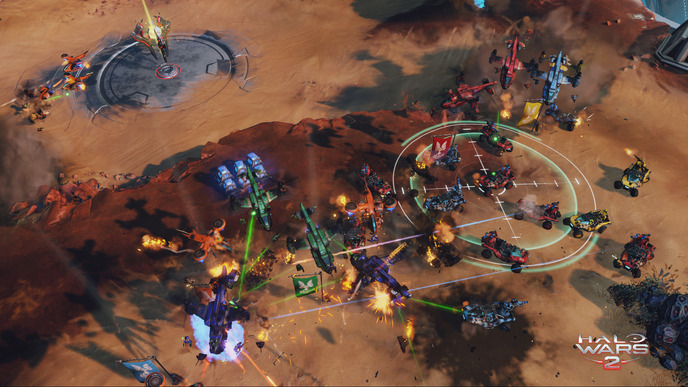
The Halo franchise began with a boast: Combat Evolved. Bungie and Microsoft bet that complex maps, vehicular warfare, and bombastic space opera would reinvigorate the console shooter. The accessible, multi-player focused shooter dominates contemporary game sales because of Halo and Halo 2. The innovations in those games reshaped a market. But with Halo Wars 2, the franchise spin-off treads water with both its chosen genre and the sci-fi universe it inhabits.
Halo Wars took the battle between humanity and the Covenant into the realm of real-time strategy in 2009 after Command & Conquer 3 momentarily revived the console real-time strategy game (RTS). But where the main shooter series balanced accessibility with layers of complexity, Halo Wars stripped the RTS down to its bare essentials at the cost of the tactical/strategic complexities that are the heart of the genre. And while the new sequel shows flashes of a possible new and faster approach to RTS matches, which too often get bogged down in micromanagement, the challenges the game offers don’t use this pace to present any other new spins on a genre that has been relatively static in terms of structure and design since Warcraft 3’s release over a decade ago.
Halo Wars 2 streamlines much of the busy work of base building and resource collection that weighs down the early stages of an RTS match. Resource generation is done through modular additions to your home base. Those same modular slots can also be used to make buildings that generate infantry/vehicle/air units. Although you’ll likely be hurting for resources at the beginning of a match, easy upgrades to your base means you’ll be flush with resources by the mid/late stages of a match.
Halo Wars 2’s strategic element then involves the make-up and allocation of your combat units. It’s a basic rock/paper/scissors set-up with infantry strong against air which is strong against vehicle which is strong against infantry. Individual unit types in those classes complicate the dynamic a little (an infantry robot who is excellent against vehicles, an anti-air vehicle, etc.) but there are enough complementary options for your squad make-up and such a surplus of resources that you rarely feel pressed for a counter.
With the exception of missions that task you with devising a defense when you’re outmanned and outgunned, strategy in Halo Wars 2 becomes rote tactics: crank out resource generating buildings, build defenses, turtle, blob the enemy once you have numerical superiority, victory. Later missions in Halo Wars 2’s campaign attempt to complicate this by starting you at massive disadvantages to your enemy, but establishing a stable defense just moves to the top of the queue and then you focus on the other priorities next.
Managing individual squads out of your larger forces is rarely a necessity in Halo Wars 2’s campaign which is both a lost opportunity and a minor blessing because Halo Wars 2’s tools for complicated squad structures are virtually non-existent. Your options for grouping units together are very limited. You can group together all of the units that are currently on screen or you can group together all of your units period. That’s it. The game will remember “squads” you form that way but forming a squadron with those tools is rarely worth the hassle but when it is needed, it becomes exhausting.
The game’s best mechanical moments are all about quickly fortifying vulnerable positions with half the tools you need to do the job. It’s fast and desperate and there’s a genuine sense that the slightest delay or poorly allocated asset will cost you victory. It’s the rare moment where the game can capture the frenzied battlefields we expect from Halo, with Scorpions, Ghosts, Banshees, and Warthogs all clashing as small armies of infantry join them in the fray. Sadly, these fast-paced melees don’t pop up nearly often enough.
The game’s handling of the Halo mythos suffers from a similar lack of inspiration. It begins with a great hook—an arrival at a new Halo structure where a rogue element of the Covenant called the Banished holds sway—that proceeds to go absolutely nowhere. Hints at the political structure of the Covenant and the culture of its Brutes lay the groundwork for a story that could show new layers of the Halo universe. But, instead, there are two Banished that speak the whole game and most of the “story” is just mission prep explaining whatever MacGuffin you need to attack/defend/control that mission. It’s Halo 2’s conflict between the Elites and the Brutes without any of the personality of the Arbiter or Tartarus.
Halo Wars 2’s compromise between strategy and speed leaves a system without a functional amount of either. Its story bears the hallmarks of the world Bungie first crafted 16 years ago without any of the melodrama or myth. Missing so much of what makes an RTS work and what makes Halo a fiction so many choose to escape into, it’s easy to wonder who Halo Wars 2 is even for.
Halo Wars 2 was developed by 343 Industries and Creative Assembly and published by Microsoft Studios. Our review is based on the Xbox One version. It is also available for PC.
Don Saas is a music and games journalist based out of West Virginia. If you want to see his rants about movies and pro wrestling, you can find him on Twitter here.
